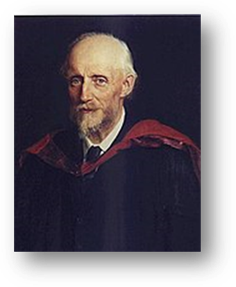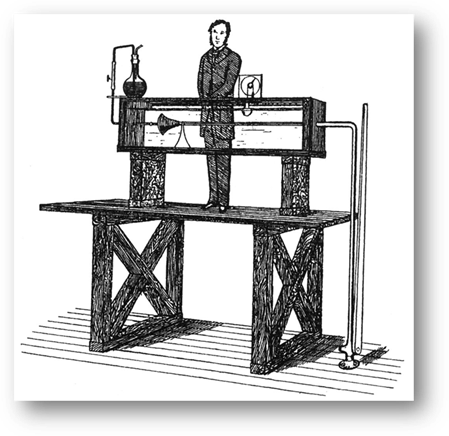|
Note: I wrote this “mini-biography,” which is part of an evolving series appearing on my website, to help inquisitive individuals of all ages learn more about engineering. We may know something about engineering because we frequently see or use the results of engineers’ efforts. Another way to learn about engineering is to meet some exemplary engineers. Osborne Reynolds, an inquisitive experimenter who advanced knowledge of fluid dynamics, is an exemplary engineer. Read his story and, if you want to know more, use the sources listed at the end of this bio.
Stuart G. Walesh, PhD, PE
stu-walesh@comcast.net
Osborne Reynolds, the first son of and named after Osborne Reynolds, was born in Belfast, Northern Ireland in 1842, and the family soon moved to Dedham, Essex, England. His mother, Jane Bryce, was widowed prior to marrying the senior Osborne. The junior Osborne’s father was a Cambridge University graduate, an Anglican priest, and headmaster of schools.
Young Osborne enjoyed a supportive and uplifting home life as indicated, in part, by this tribute to his father: “In my boyhood I had the advantage of the constant guidance of my father, also a lover of mechanics, and a man of no mean attainments in mathematics and its application to physics.” 1
Education, Early Experience, and Family Life
In his late teens, Reynolds apprenticed for one year in an engineering firm. He gained experience with the manufacture and fitting out of coastal steamers, which, in turn, probably provided initial insight into the value of learning about fluid dynamics. Improved understanding of fluid flow was to be the dominant thread of his later accomplishments.
Reynolds then attended and, in 1867, graduated from Queens’ College at Cambridge University. He studied mathematics at Cambridge because he “had an irresistible liking for mechanics and the physical laws on which mechanics is based” and he saw that mathematics knowledge was essential for understanding mechanics.
Immediately after college graduation, Reynolds worked at an engineering firm for one year as a civil engineer. His involvement on the company’s London sewage system project probably furthered his interest in the practical aspects of fluid dynamics.2
In 1868, Reynolds married Charlotte Jemima Chadwick and they soon had a son—another Osborne! Unfortunately, in the first of a pair of tragedies, Charlotte died the following year of unknown causes leaving Reynolds with the responsibility of caring for his newborn son. A decade later, he dealt with the death of his only child.3 Several years later, in 1881, Reynolds married Annie Charlotte Wilkinson and they had a girl and three boys—no more Osbornes.4
Professor
In 1868, at the young age of 25, he became the first professor of engineering at Owens College in Manchester, England where he chaired the civil and mechanical engineering department. That appointment, created and funded by Manchester-area manufacturers, also made him the second engineering professor in all of England. Owens College later became the University of Manchester, which it is today.
Reynolds held the professor position for 37 years, ending with his retirement in 1905. The following image shows him as he appeared in 1903, two years before retiring and nine years before his passing.5

At the time of Reynolds becoming a professor, engineering education was new within English universities. He apparently saw this as an opportunity to influence how education should evolve. For example, Reynolds advocated that all engineering students, regardless of their specialty, have a common background that included mathematics, physics, and the fundamentals of classical mechanics.
Paradoxically, while the scholarly Reynolds had firm ideas about the content of engineering education, he was a poor lecturer—a poor deliverer of content. Reynolds was “difficult to follow” and often “wandered among topics with little or no connection.”6
Researcher
Initial limited laboratory space in which to conduct research caused Reynolds and his students to do, what one those students called, “out-of-door physics.” They studied and tried to explain natural phenomena such as tails of comets, terrestrial magnetism, cloud electrical properties, bursting of trees struck by lightning, snowflake formation, and calming seas by spreading oil.
As space and resources became available in the later 1870s, research shifted to more general fluid flow phenomena. For example, he led studies of waves in deep water, motion of vortices, heat transfer, improvement of screw propellers, and enhancing performance of turbines and centrifugal pumps.7
Using flow of water in a horizontal transparent glass pipe, into which dye was injected, Reynolds defined conditions under which flow transitioned from, what we now call, laminar flow to turbulent flow. His experimental apparatus, as illustrated here,8 will resonate with almost anyone who has conducted laboratory studies involving fluid flow. The successful result typically requires great effort, characterized by learning through trial and error.

Reynolds shared the research results in his 1883 paper “An Experimental Investigation of Circumstances Which Determine Whether the Motion of Water Shall be Direct or Sinuous, and of the Laws of Resistance in Parallel Channels.” Note his use then of the words “Direct” and “Sinuous” for which we now use “laminar” and “turbulent.”
In his paper, he effectively described the two very different flow regimes. He stated, “the internal motion of water assumes one or the other of two broadly distinguishable forms—either the elements of the fluid follow one another along lines of motion which lead in the most direct manner to their destination, or they eddy about in sinuous paths, the most indirect possible.” His description almost suggests that the flowing water has a mind of its own.
Reynolds concluded that the occurrence of laminar or turbulent flow depended on these four attributes of a particular flow situation:
- characteristic velocity
- characteristic length
- density of the liquid
- viscosity of the liquid
That discovery led to the definition of the dimensionless parameter calculated as (velocity) x (length) x (density) / (viscosity). In recognition of Reynolds’ contribution, the parameter is now called the Reynolds Number, R. He and others concluded that if R was less than about 2000, flow would be laminar, if over 2000, turbulent. Reynolds research findings proved to be widely applicable in the analysis, physical modeling, and design of a wide variety of fluid flow systems and structures.9,10
Unsuccessful Professional Moves
Although Reynolds and his students were conducting useful research at what is now the University of Manchester, he pursued other academic options. In 1884, one year after publishing his pivotal paper, he applied for the position of Chair in Civil and Mechanical Engineering at what is now City and Guilds College in London. He was not successful.
Apparently undeterred, he soon sought the position of Cavendish Professor of Experimental Physics at Cambridge University. Reynolds lost out to 27-year-old J. J. Thompson, his former student, who went on to become a Nobel Laureate and President of the Royal Society. One can imagine Reynolds’ mixed emotions—sadness in not obtaining the desired academic position and pride in the achievements of one of his students. As noted earlier, Reynolds spent the rest of his career at the University of Manchester during which he continued to lead productive fluid dynamics studies the results of which are used across engineering disciplines.11
Honors
Colleagues and others recognized Reynolds’ contributions to fluid dynamics in various ways, including the following:
- 1877: Elected a Fellow of the Royal Society12
- 1884: University of Glasgow honorary doctorate.13
- 1888: Royal Society’s Royal Medal “for his investigations in mathematical and experimental physics, and on the application of scientific theory to engineering.” 14
- 1903: Manchester Literary and Philosophical Society Dalton Medal for “distinguished contribution to science.” 15
Reynolds died of influenza on February 21, 1912 at Watchet in Somerset, England. He was buried at the Church of St. Decuman in Watchet.
Cited Sources:
1) O’Connor, J. J. and E. F. Robertson. 2003. “Osborne Reynolds.” MT MacTutor. St. Andrews, Scotland: School of Mathematics and Statistics, University of St. Andrews. https://mathshistory.st-andrews.ac.uk/HistTopics/, accessed August 29, 2022.
2) Wikipedia. 2022. “Osborne Reynolds.” https://en.wikipedia.org/wiki/Osborne_Reynolds, accessed August 29, 2022.
3) Launder, B. 2009. “Osborne Reynolds: The Turbulent Years.” https://hal.archives-ouvertes.fr/hal-03378653/document , accessed August 29, 2022.
4) O’Connor, J. J. and E. F. Robertson. 2003. “Osborne Reynolds.”
5) Wikipedia. 2022. “Osborne Reynolds.”
6) O’Connor, J. J. and E. F. Robertson. 2003. “Osborne Reynolds.”
7) Launder, B. 2009. “Osborne Reynolds: The Turbulent Years.”
8) Wikipedia. 2022. “Osborne Reynolds.”
9) Streeter, V. L. 1958. Fluid Mechanics. Chapter 4, “Viscous Effects-Fluid Resistance.” New York: McGraw-Hill.
10) Launder, B. 2009. “Osborne Reynolds: The Turbulent Years.”
11) Launder, B. 2009. “Osborne Reynolds: The Turbulent Years.”
12) Wikipedia. 2022. “Osborne Reynolds.”
13) Launder, B. 2009. “Osborne Reynolds: The Turbulent Years.”
14) Launder, B. 2009. “Osborne Reynolds: The Turbulent Years.”
15) Wikipedia. 2022. “Osborne Reynolds.”
Source of images: Source 2.
Note: Want to learn more about engineer exemplars and engineering excellence? See Chapter 2 in my book Engineering’s Public-Protection Predicament.
Learn More About Stu Walesh | Clients Served | Testimonials & Reviews
Managing and Leading Books | Tailored Education & Training
Home | Legal Notice | Privacy Statement | Site Map
Copyright © Stuart G. Walesh Ph.D. P.E. Dist.M.ASCE
Web Site Design, Hosting & Maintenance By Catalyst Marketing / Worryfree Websites |

